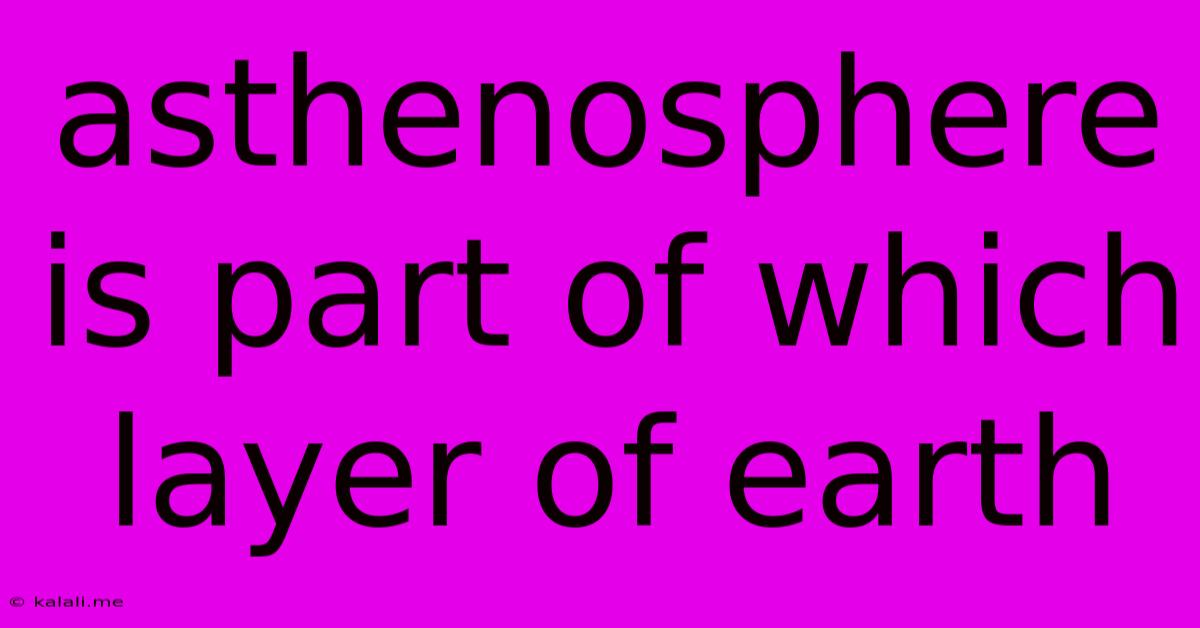Asthenosphere Is Part Of Which Layer Of Earth
Kalali
Jun 15, 2025 · 3 min read

Table of Contents
Asthenosphere: Part of the Earth's Mantle
The asthenosphere is a vital part of the Earth's structure, playing a crucial role in plate tectonics and the planet's overall geological processes. Understanding its location within the Earth's layers is key to comprehending its function and significance. This article will delve into the asthenosphere's position, its properties, and its relationship with the Earth's mantle.
The asthenosphere is part of the Earth's mantle, specifically the upper mantle. It sits beneath the lithosphere, which comprises the Earth's crust and the uppermost, rigid part of the mantle. Think of it as a relatively weak, partially molten layer underlying the strong, rigid lithosphere. This distinction in physical properties is crucial to understanding plate tectonics.
Defining the Asthenosphere
The asthenosphere isn't a distinct layer with sharp boundaries like the crust and mantle. Instead, it's defined by its rheological properties, meaning its behavior under stress. It's characterized by:
- Ductility: The asthenosphere is ductile, meaning it can deform and flow over long periods under pressure. This contrasts with the brittle behavior of the overlying lithosphere, which fractures under stress.
- Partial Melting: The asthenosphere is not entirely molten, but contains a small percentage of melt. This melt significantly reduces the asthenosphere's viscosity, allowing for the slow, convective flow that drives plate tectonics.
- Low Seismic Wave Velocity: Seismic waves, produced by earthquakes, travel slower through the asthenosphere than through the overlying lithosphere. This reduced velocity is a key indicator of the asthenosphere's lower rigidity and partial melting.
The Asthenosphere's Role in Plate Tectonics
The asthenosphere's ductility and partial melting are fundamental to plate tectonics. The slow, convective movement of the asthenosphere acts as a driving force for the movement of the rigid lithospheric plates. This movement is responsible for:
- Seafloor Spreading: At mid-ocean ridges, molten material from the asthenosphere rises to the surface, creating new oceanic crust and pushing existing plates apart.
- Subduction: At subduction zones, one tectonic plate slides beneath another, often sinking into the asthenosphere.
- Earthquakes and Volcanoes: The movement and interaction of tectonic plates at plate boundaries, influenced by the asthenosphere's flow, cause earthquakes and volcanic activity.
The Asthenosphere and the Mantle's Layers
It's important to clarify the relationship between the asthenosphere and the broader mantle structure. The mantle itself is divided into the upper mantle and the lower mantle. The asthenosphere is primarily located within the upper mantle, but its exact depth and extent can vary depending on location and geological factors. The lower mantle is much denser and more rigid than the asthenosphere. The transition between the asthenosphere and the lower mantle is gradual, with a progressive increase in density and rigidity.
In Conclusion
The asthenosphere, a crucial part of the Earth's upper mantle, plays a vital role in shaping the planet's geology. Its ductile nature and partial melting drive plate tectonics, influencing earthquakes, volcanoes, seafloor spreading, and subduction. While not a distinctly separate layer, its rheological properties distinguish it from the rigid lithosphere and the denser lower mantle, making it a key component in understanding Earth's dynamic processes.
Latest Posts
Latest Posts
-
Which Of The Following Is Not A Symptom Of Alcoholism
Jun 15, 2025
-
Which Of The Following Does Not Conduct Nitrogen Fixation
Jun 15, 2025
-
Anything That Occupies Space And Has A Mass
Jun 15, 2025
-
An Electromagnet Is A With A Core
Jun 15, 2025
-
How Is An Observation Different From An Inference
Jun 15, 2025
Related Post
Thank you for visiting our website which covers about Asthenosphere Is Part Of Which Layer Of Earth . We hope the information provided has been useful to you. Feel free to contact us if you have any questions or need further assistance. See you next time and don't miss to bookmark.